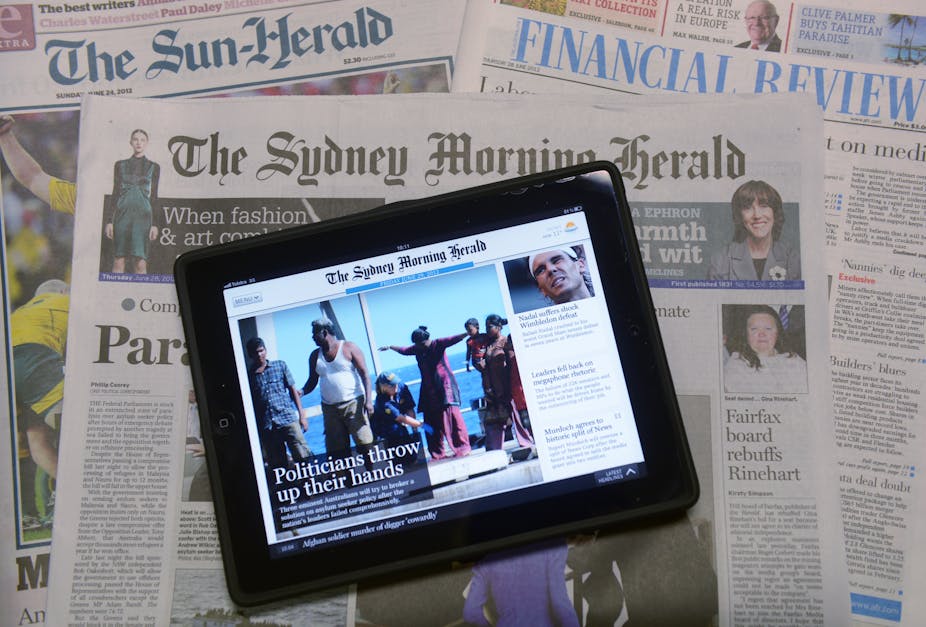Rachel Buchanan’s new book Stop Press: The Last Days of Newspapers is part of what independent publishing house Scribe calls the “Media Chronicles”:
A series of first-person accounts about the dramatic and profound changes underway in the mass media.
I first read about Buchanan’s book when an op-ed by Buchanan, printed in The Age, was shared by a former journalism student on my Facebook feed. It was designed to ruffle feathers – a piece that suggested universities were hoodwinking young hopefuls by training them in newspaper reporting skills they would never practically be able to use.
It worked, as journalism educators around the country jumped to defend their training regimes, pointing out the value of journalism degrees and the number of journalism jobs outside newspapers.
Fairfax Media, which used to be simply called The Age or the Sydney Morning Herald, did the wrong thing in printing an article (based on the content of the book) that shamefully misrepresented the true intent of Buchanan’s book, and the educators (including myself) did the wrong thing by not taking the time to read the entire work before reacting in print. In the “old days” of newspapers (circa 1990) that wouldn’t have happened.
Buchanan’s book reads like a love letter to the heyday of journalism, where new technology (computers and mobile phones) made the work much easier and the stories that much more fun. It details the last 30 years with stories of the feared but respected sub-editors, the faceless people who fixed grammar and wrote pithy headlines, who could put a reporter in his or her place with one witty putdown.
The book has wistful tales of smoke-filled days working on important, and not-so-important, newspaper articles in Australia and New Zealand. Buchanan describes the newspapers of old as:
A sweet form of manufacturing: literary, pugnacious, political and smart. Gorgeous, solid old buildings were filled from basement to turret with blue-collar intellectuals. Compositors who knew the name of every politician and rugby player, men who could spot a split infinitive through a fug of Captain Plain and a smear of ink. Drinkers, depressives, dreamers, pedants, oddballs, watchers, readers, writers – newspapers were full of people on the make.
Much of the book’s strength lies in Buchanan’s research skills. She uses personal anecdotes to bring to life details of the outsourcing of some of the jobs involved in daily newspaper production to places with a cheaper labour market, such as New Zealand (sub-editing), the Philippines (photos and phones) and India (advertising).
Buchanan also tearfully notes the loss of jobs among those who are rarely mentioned, from the printers in a purpose-built press building on Melbourne’s outer fringe, to the papermakers in Tasmania. Change, she notes, “can bring opportunity (for a few), but it also brings loss and suffering, the urge to reflect”.
There is much evidence of what is wrong with newspapers right now. Buchanan argues that little of what is in newspapers “has to do with the democratic theory and citizenship rhetoric favoured by journalism scholars and commentators and by many journalists themselves”. She writes that online editors had become king, and “news had become a popularity contest, in which cheap, tasteless, and sometimes sexist ‘clickbait’ was thrown into the mix”.

But Buchanan also misses what I believe is the most important point in the story of the death of newspapers. Why didn’t print journalists and newspaper business managers see the change coming, and react much faster? Print journalists have always been considered the serious thinkers in the industry, but seemed somehow to believe they had a special power that would keep them immune to change.
Newspaper reporters have for a long time divided the work into two areas – serious journalists (politics, investigative and business) and “the others”. But the serious journalists have continued to write in the same old way, using the same old hegemonic talent and leaving the readers expecting the same old thing. The lifestyle journalists have honed their writing and skills and delivered beautiful articles which don’t date – and therefore don’t need to be on a daily news platform.
As a result, both groups have written themselves out of print journalism jobs. People will pay for beauty (lifestyle work) and sport, but the challenge now is how to get Australians to pay for the serious journalism the country needs to keep an eye on all those people who have power, be they politicians or corporations.
Journalism is not dead. It’s a point that Rachel Buchanan’s book makes, but not until page 165. I hope the journalism students I teach can make their point much earlier, but with the same thorough research and beautiful writing style Buchanan’s book shows. I teach them to write in the present tense, looking to the future not the past.
In my world, the teaching of these skills is certainly not dead. But as one of Buchanan’s interviewees notes, it’s the journalism that matters most. We need to save journalism.

